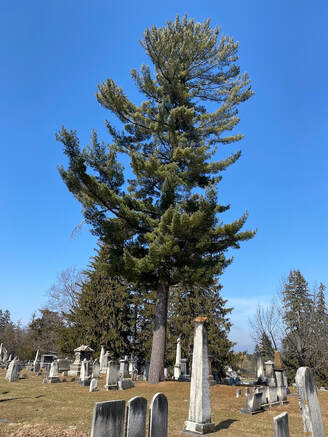 At one time, the Eastern White Pine (Pinus strobus) dominated the northeastern forests of the U.S. and had multiple uses for both the Native Americans and the colonists. Its durable wood and straight trunk made it a valuable commodity during colonial times in the U.S. Because of its value, the white pine was at the center of numerous skirmishes between colonists and the men in charge of enforcing English laws on harvesting white pines for private use. White pines grow rapidly and have longevity, some living as long as four hundred years. When the colonists arrived in New England in the early 1600s, they found virginal forests of pine and discovered trees towering over 200 feet in the air with bases several feet in diameter. They also noticed how the Native Americans used the trees for utilitarian as well as medicinal purposes. Algonquins steeped the needles and inner bark to make a tea to prevent scurvy earning them the nick-name 'bark-eaters'. The Haudenosaunee (Iroquois - Five Nations) culture refer to the white pine as the Tree of Peace. Historical accounts of a peace treaty agreed upon between the Mohawk, Onondaga, Seneca, Cayuga, and Oneida tribes, occurred after a meeting under the canopy of this majestic tree. And in a testament to the significance of the white pine to their culture, (the five needles represent the tribes) the tree is at the center of the Haudenosaunee seal.
0 Comments
And that's ok."  It has taken me a whole year - and I'm not quite finished yet - to read the Pulitzer Prize winning novel The Overstory. And it has been a struggle to get as far as I have in the book. The first part of the book introduces the reader to eight characters. From then on, each chapter, even within chapters if you can call them chapters, reveal a new point of view from characters that you are supposed to remember being introduced to a number of pages prior. It's all very confusing and I would have given up if not for the fact that the writing is so beautiful. It's about trees, but also about human connection to trees and the will of some to fight for trees to be treated as a legal entity - with rights. The most interesting part to me has been the description of a couple who climb a mammoth Redwood in Oregon to try and save it from loggers. The vivid scenes of them swaying in the wind and watching the stars at night made me wonder if the author, Richard Powers, had actually stayed in a tree house to write about the experience. I started the novel before Covid lockdowns, having heard some recommendations from friends. I've spent most of my career educating about and advocating for the natural world so I thought, right up my alley. Once Covid hit and I got into the middle part of the story where the chapters intertwine various characters, my head started to spin and I lost interest. I relegated the book to the shelf in the basement where I keep books to donate to the library for their annual sale. Wouldn't you know it, the library closed and there was no sale. So when our book club met outside around a fire pit one cool evening in the late summer I was reminded about the book by a friend who had finished and loved it. "Maybe I'll give it another try," I thought. I dug it out of the pile of books that had been accumulating all year and started reading again. I didn't bother going back to figure out who was who because I decided the best way to get to the end was not to worry if I couldn't keep track. Life has been like that with Covid. I try not to worry too much about things I can't control (like someone else's story structure) so that I can enjoy the day to day living that is required to get by in these trying times. If I can keep my health, take a walk, talk to my family, and pet my cats, I'd say my life is pretty full. I have a lot to be grateful for. So if it takes me another year to finish this book (because I now have two more books I'm reading sitting by bed stand and on my Kindle), then who cares? I'm just relishing the writing. I'm just enjoying the pleasure of reading while I am able. |
AuthorSheila Myers is an award winning author and Professor at a small college in Upstate NY. She enjoys writing, swimming in lakes, and walking in nature. Not always in that order. Archives
April 2024
CategoriesAll Adirondacks Algonquin Appalachia Award Cades Cove Canada Chestnut Trees Christmas Civilian Conservation Corps Collis P. Huntington Creativity Doc Durant Durant Family Saga Emma Bell Miles Finger Lakes Great Depression Hell On Wheels Historical Fiction History Horace Kephart Imagination National Parks Nature Publishing Review Screenplay Short Story Smoky Mountains Snow Storm Stone Canoe Literary Magazine Thomas Durant Timber Wilderness World War II Writing |
|
|
All materials Copyright 2022
Any reproduction, reprint or publication without written consent of author prohibited. |

 RSS Feed
RSS Feed